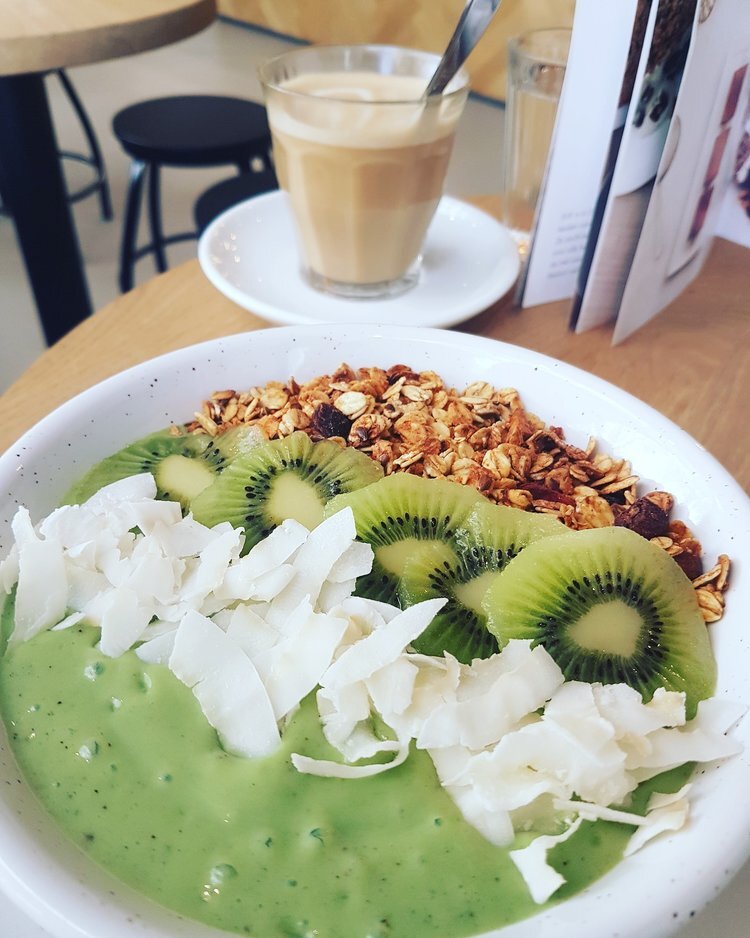HOW TO CHOOSE A SMOOTHIE
SO, YOU WANT TO EAT HEALTHIER.
OR YOU JUST NEED SOME POST-WORKOUT PROTEIN.
Whatever your goals, smoothies can be a great way to get there!
Before we get to my go-to smoothie template, let’s talk about how to know what type of smoothie you need!
Meal Replacement or Breakfast Smoothie
Smoothies are a great way to start the day, or end it! If you feel like you need extra nutrients in your day, you’re too busy to cook a meal, or you need something on-the-go, a good smoothie’s got your back. Here’s the thing: smoothies can have a ton of sugar, and that will make you hungry again in a couple of hours. In order to make your smoothie actually be a meal replacement, remember 2 important things:
1) BALANCE PROTEIN, FAT, AND CARBS TO KEEP YOUR BLOOD SUGAR STABLE
2) MAKE YOUR SMOOTHIE CALORICALLY DENSE ENOUGH
Aim for about equal amounts of protein, fat, and carbohydrates in order to keep your tummy happy and full. And since you’re not eating a regular meal, make sure you have plenty of calories in your liquid meal! Anywhere from 350-600 is a good goal if you’re counting, although you certainly don’t have to count in order to know it’s enough. Just try it out and see how long it satisfies you. Next time, make adjustments if needed.
Pre-Workout Smoothie
Did you know you can have a smoothie before your workout? This was a bit of a surprise to me when I studied sports nutrition because I prefer to workout on an empty (or mostly empty) stomach. If your workout is not first thing in the morning, you should eat by the time you get there. What if food makes you nauseous during the workout? This is where a smoothie can be your best friend. Here’s the key:
1) BALANCE CARBS WITH A LITTLE PROTEIN, AND MINIMAL FAT
2) KEEP IT SMALL
During your workout, your body uses carbohydrates for energy and protein to rebuild muscle as soon as possible. Carbs digest quickly and are less likely to make you nauseous, while protein keeps your blood sugar stable. Fat slows down digestion, which is normally a good thing, but we want it quick for this purpose. Fat also requires gallbladder action to digest. which can cause nausea. As for the size, you don’t need a full meal, just a bit of energy to boost your performance. You can look forward to a full recovery meal after your workout.
Post-Workout Smoothie
So you just got back from the gym, or your run, or yoga. And you’re starving. Or maybe you’re not, but it’s a couple of hours until dinner and you know you’ll eat all the things if you wait that long. Your blood sugar is low because of all the energy you just used, and you need to balance it. Enter my personal favorite, the post-workout smoothie.
1) PROTEIN AND CARBS
2) CARDIO RECOVERY VS. MUSCLE BUILDER SMOOTHIE
Your precise nutrient needs will vary according to what kind of workout you did, but the basic format is protein + carbs. You need lots of protein to replenish muscle tissue. Carbohydrates prompt insulin activity, which is needed to get protein into your muscles. If you did a 3 mile run or Zumba, then a lighter smoothie with 15-20 grams of protein and about the same amount of carbohydrates is ideal. If you just bested your deadlift PR, you'll need a heftier amount of protein and carbs. Somewhere between 20 and 30 grams will work. If you spent an hour weightlifting and then you did some cardio, dude. Stop reading. Make this smoothie into a meal or have a light smoothie and get yourself some serious chow, stat.
Snack Smoothie
The snack smoothie is great for when it’s 3 pm and you need a pick-me-up that isn’t coffee. It’s also nice to have as a meal component (smoothie and charcuterie? smoothie and pancakes?). The format for a snack smoothie is the same as a meal-replacement smoothie, just smaller.
1) BALANCE PROTEIN, FAT, AND CARBS TO KEEP YOUR BLOOD SUGAR STABLE
2) MAKE IT FUN-SIZE!
If you focus on filling your smoothie with equal parts protein, fat, and carbohydrates, you’ll have a satisfying snack that is tasty and colorful to boot. If you made a breakfast smoothie and had leftovers, put them in a mason jar in the fridge and use that as a snack later! Or make yourself a regular smoothie and save half for later.
Nutrient-Dense Supplement Smoothie
This type of smoothie is focused on nutrient density and healing more than taste, although it can be very tasty! Rather than fulfilling a specific macronutrient ratio, this smoothie offers a one-two punch for your immune system, brain, skin, hair, nails, and hormones.
1) PILE IN ALL OF THE “SUPERFOODS”
2) PINCH YOUR NOSE AND TAKE A SHOT
My nickname for this smoothie is “dumpster smoothie,” because you can throw anything in there! Include a rainbow of colorful fruits and veggies or focus on one category of phytonutrient (just greens or reds, for example). Things that you might not add to a regular smoothie go here: beets, watercress, sweet potato, dragonfruit, cauliflower, etc. If you have fresh herbs (parsley, cilantro, basil, thyme, oregano), through them in. Superfruit powders (acai, goji, camu camu, maca, cacao)? A good teaspoon or tablespoon of each. Garlic? Well if it’s a veggie-based smoothie, it’ll work!
HERE’S TO SMOOTHIE MUSTACHES!







